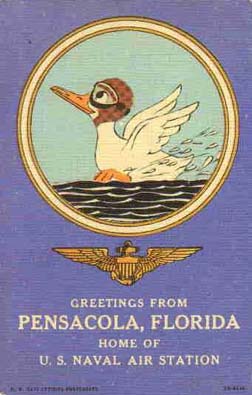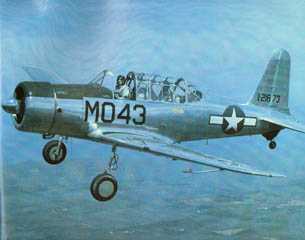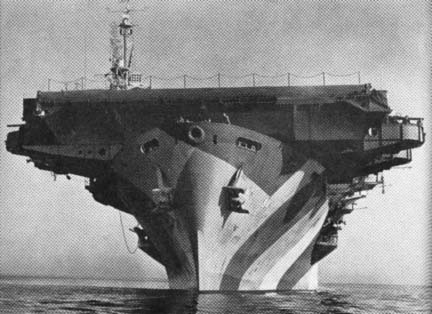CHAPTER 7
AUGUST 1, 1943--JANUARY 25, 1944
NAS Pensacola, FL.--BASIC, INSTRUMENT, ADVANCED
FLIGHT TRAINING AND GRADUATION |
And so after successfully completing both the ground school
and the five stages of flying, we boarded a train for an over
night ride from Ottumwa, Iowa to Pensacola, Florida. The pullman
we were assigned to had one less bunk than the number of cadets
assigned to it. The odd guy without a bunk turned out to be John
August Munson, a CPT/WTS student who had been at Morningside
college in Sioux City with my brother, Carl. He and his buddy,
Gene Rife, another guy from Sioux City, had managed to get to
the train last and Munson didn't get a bunk. So wouldn't you
know since I had the lower bunk and Rife an upper, Munson piled
in with me. In those days homosexuality wasn't on everybody's
mind and no one thought any thing of two men sleeping in the
same bunk. Not so today!

The required postcard home |
Our destination in Pensacola was the Pensacola Naval Air
Station, the "Annapolis of the Air". This is one of
the two final squadrons, the other being Corpus Christi Naval
Air Station, where half the Navy cadets who have completed primary
schools around the United States, and even some cadets from foreign
countries, come for the final stages of their training before
becoming full fledged Naval Aviators, presented their "Wings
of Gold" and are commissioned as Ensigns in the United States
Navy by proclamation of the Congress of the United States of
America. To me and to everyone else it was no small honor. This
I assure you!
Once we were checked into NAS Pensacola we were assigned to one
of two out lying stations for basic training. These stations
were Sauffley field and Ellison field, both named after early
naval aviation heroes. I drew Ellison. It was the usual half-day
ground school and half-day flying. |
The planes we would be flying were the PT- 19, Vultee Valient
or the Vultee Vibrator as the cadets called it. In the Navy it
was known as the SNV. It was an all-metal, low-winged monoplane,
considerably heavier than the Stearman with a little more horsepower.
It, too, was a two seat, in tandem plane with a radio in place
of the "gosport" arrangement in the Stearman. One stipulation
on the plane was that, as far as the Navy was concerned, it was
not constructed for acrobatics and as far as stunts were concerned---no
dice. The Army Air Corps had no such restrictions.
|
Basic training was a short course designed to make a transition
from the Stearman to a more combat like plane, the SNV. Here
again the SNV was not a hard plane to fly but that didn't stop
me from getting into trouble. My first "faux pas" occurred
when I was taxiing out to the end of the runway with my instructor
and another cadet for a three-plane formation take-off. During
the taxi out the pilot has to lower the flaps. This requires
twenty-eight turns of the flap crank. I was in the process of
cranking when I had to throttle back to keep from over running
the plane ahead. |

Vultee Valient, BT 19
"Vultee Vibrator" |
Beings you use the same hand for cranking and jockeying the throttle,
I paused in the cranking after 14 turns of the 28 necessary.
When I continued cranking I cranked 14 turns in the opposite
direction, hence, no flaps, a situation I was unaware of. On
the run down the runway the wingmen are suppose to lift off before
the flight leader, in this case the instructor. We were rolling
along at what seemed to a very low speed. I couldn't lift the
plane off the runway. All of a sudden the instructor poured the
juice to his plane and I did the same. We left the other plane
dragging way behind. Once we were in the air the instructor gave
a hand signal that my flaps were up. I instantly knew that was
the reason my plane was heavy. It doesn't require nearly as much
air speed to raise a plane with flaps as it does without. The
instructor was rather understanding about my explanation of counting.
I didn't find that my error was necessarily a dangerous one in
that the take-off was accomplished without any difficulty even
though we had used up a good portion of the runway before the
instructor looked back and saw my predicament. I was rather amused
when a few days later I was reading the Pensacola paper and saw
a picture of Ted William's, the Boston Red Sox baseball player,
and read how he narrowly missed death when he took off in his
SNV with the flaps up. A newspaper will print anything for news.
Not only was the story "bullshit", but in the picture
"ole" Ted had the epaulets on his dress white uniform
snapped on upside-down. Not only did I read it, but someone else
pinned the picture to the bulletin board in the barracks.

USS Lunga Point, CVE 94. Another of the 50 Casablanca class escort
carriers that were built. These included also the authors ships
USS Petrof Bay and Steamer Bay. |
I'm not saying that is the only error I made. On one of my check
rides I was to make practice landings. The instructor, whose
name I believe was Lt. (jg) Weiss, told me to make the approach
at 90 knots. My air speed ran between 85 and 95 knots. I couldn't
control the speed because of the rough air. Maybe it was because
of the rough air and maybe not. Anyway, the "ass" flew
into a rage because of my lack of "ability". Berated
me up one side and down the other side, told me I was too dumb
to be a Navy flier and gave me a "down". I would gladly
have killed the "Son of a Bitch" on the spot.
Once we were back on the field I met with my instructor and was
so depressed that I made the mistake of saying that I might as
well quit! Something that influenced a rash statement like this
was the fact that an order came out stating that any cadet who
remained in the program after the 3rd of September would no longer
be able to resign from the Navy but would go directly Great Lakes
Training Station as a seaman second class. Those who desired
not to accept this would be released from the program and returned
to civilian life as of this date. The third of September just
happened to be the next day. The instructor said "I wish
you hadn't said that, I would have given you extra time, but
now I would hold myself responsible if anything happened to you.
But, if you wish, I will try to get you board time". Now
I was in a predicament, do I go or do I stay. At any other time
there would be no question, I could take the board time and if
I failed I could get out. But not now, that evening I had a pocket
full of quarters, puzzling over whether I should make the call
home telling them I was a quitter. Well, I never made the call,
the instructor got me the board time and I never looked back.
What piss-poor timing! I have never forgiven that horse's ass
Weiss.
From basic all cadets went to Whiting field, another out-lying
field, for instrument training. It was a relatively short course
for learning to fly on instruments and to study navigation including
celestial navigation. Flying a plane under a hood makes you blind
to the outside world and you are forced to control the plane
on instruments. Don't know how well I did with the blind flying
but I didn't crash and I did pass the check. I must have learned
something for I was called upon to use these techniques many
times later on.
One of the two other things I remember about NAS Whiting was
sitting in a classroom with the only other fellow American cadet
by the name of Allen. He was the other cadet in the three-plane
take-off at NAS Ellison who was left on the runway. Also in the
class were 18 Sub-Lieutenants of the British Royal Navy who were
here for the same reason as the USA cadets-to learn to fly. Sitting
in the classroom with my mind somewhere on "cloud nine"
the instructor suddenly asked me " What is the most dangerous
situation you can get into in an airplane?" Not having really
heard the question, I was stumbling over the question and the
answer when I heard one of the Sub-lieutenants whisper "a
flat spin." I repeated the whispered answer to the instructor
and again escaped by the skin of my teeth. Since that time I
have a warm place in my heart for the Royal Navy. A few years
later as I was reminiscing about the past, I began to wonder
why I didn't know and why I should have had any reason to be
embarrassed because I was not familiar with the term "flat
spin". To the best of my knowledge I had never heard of
the term and it had not been a term used in courses of flying
or ground school, either in lectures or in textbooks. As for
textbooks, I think I'm safe in saying that I was never issued
a textbook all the time I was in the Navy. One would think that
a flying instructor would have mentioned it with the idea of
promoting safety or that it would have been a part of the "Theory
of Flight" or in the lectures on aircraft construction and
maintenance. Don't remember hearing the words until I was asked
that question. So would I have been reprimanded for not knowing
the answer? Maybe not. For anyone who doesn't know the meaning
of the term and might be interested, it is this: An airplane
is designed and constructed with a center of gravity point along
the longitudinal axis of the fuselage of the airplane. This means
that the weight forward of this point is exactly equal to the
weight aft. It would balance perfectly on a fulcrum. The plane
is constructed with the weight a little heavier on the forward
half. The reason for this is so that in case of engine failure
the nose will fall first there by gaining speed and increasing
the wind over the control surfaces. If the after-section of the
plane were heavier the tail would fall quickest and the pilot
would not be able to gain control of the aircraft there by spinning
to earth.
|